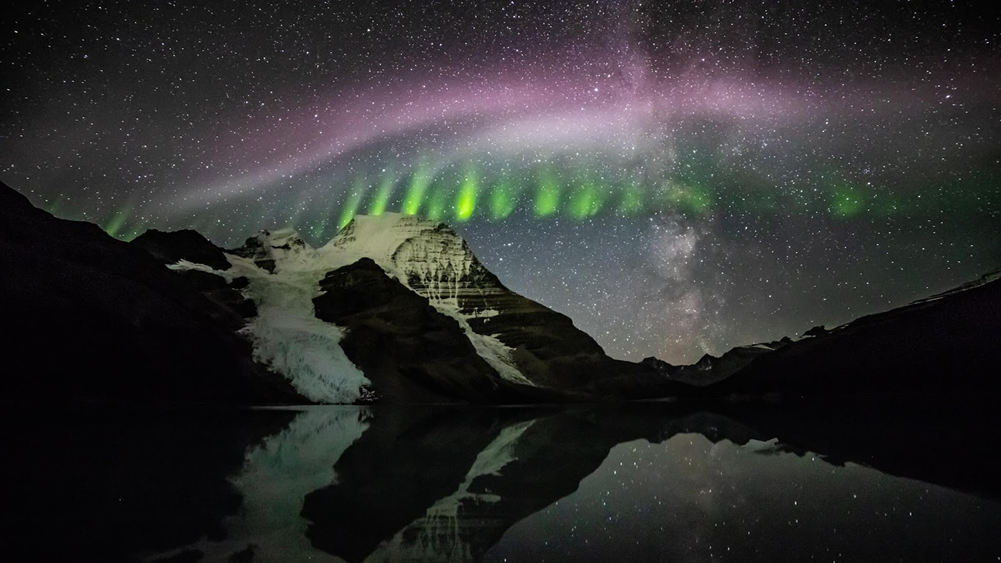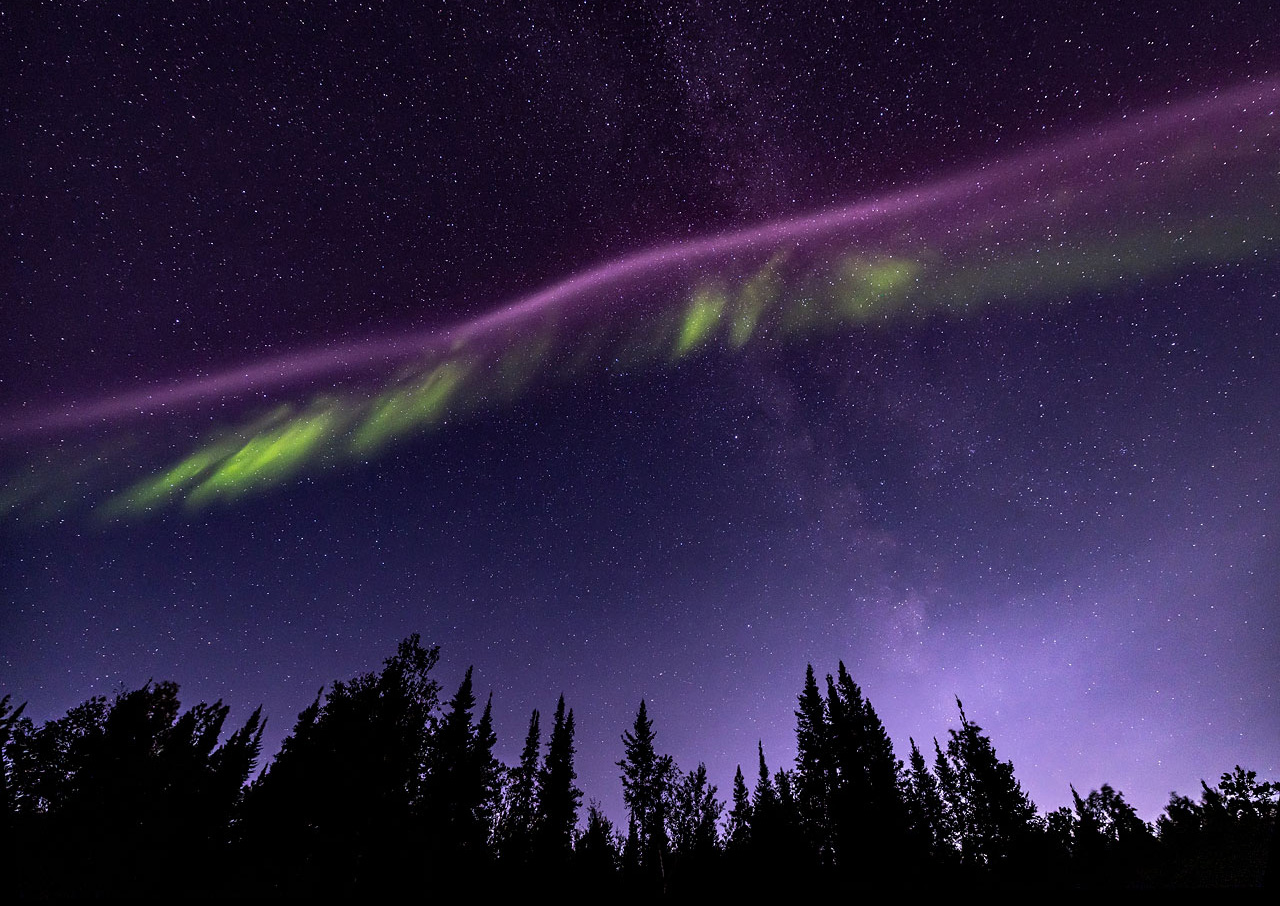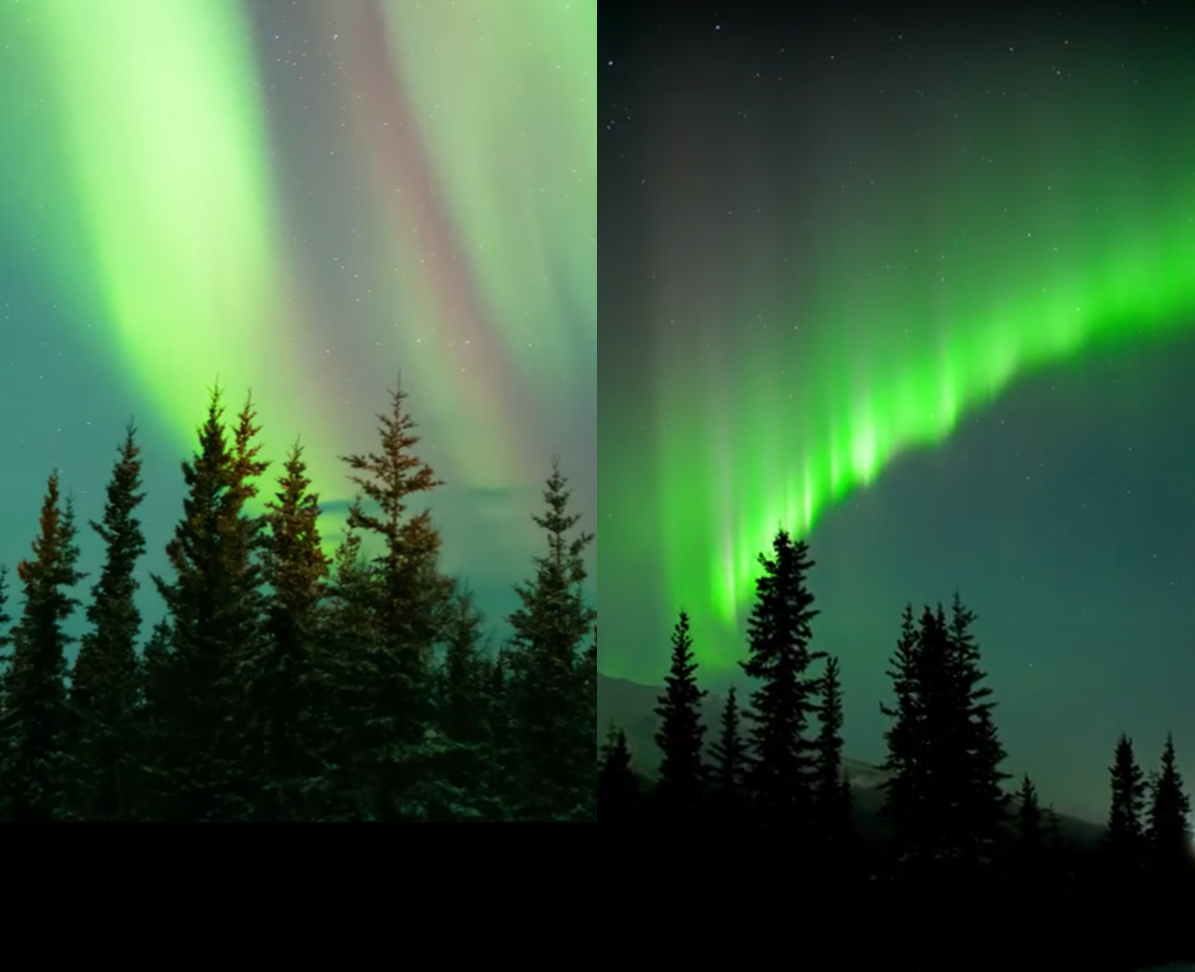When is an aurora not an aurora?
Phenomena called "Steve" and "picket fence" are masquerading as auroras, graduate student argues.

Courtesy of Robert Downie, robertdowniephotography.com
December 8, 2023
The shimmering green, red and purple curtains of the northern and southern lights — the auroras — may be the best-known phenomena lighting up the nighttime sky, but the most mysterious are the mauve and white streaks called Steve and their frequent companion, a glowing green “picket fence.”
First recognized in 2018 as distinct from the common auroras, Steve — a tongue-in-cheek reference to the benign name given a scary hedge in a 2006 children’s movie — and its associated picket fence were nevertheless thought to be caused by the same physical processes. But scientists were left scratching their heads about how these glowing emissions were produced.
Claire Gasque, a University of California, Berkeley, graduate student in physics, has now proposed a physical explanation for these phenomena that is totally different from the processes responsible for the well-known auroras. She has teamed up with researchers at the campus’s Space Sciences Laboratory (SSL) to propose that NASA launch a rocket into the heart of the aurora to find out if she’s correct.
Vibrant auroras and glowing phenomena such as Steve and the picket fence are becoming more common as the sun enters the active period of its 11-year cycle, and November was a good month for Steve observations in the northern latitudes. Because all these transient luminous phenomena are triggered by solar storms and coronal mass ejections from the sun, the approaching solar maximum is an ideal time to study rare events like Steve and the picket fence.
Gasque described the physics behind the picket fence in a paper published last month in the journal Geophysical Research Letters and will discuss the results on Dec. 14 in an invited talk at the American Geophysical Union meeting in San Francisco.
She calculated that in a region of the upper atmosphere farther south than that in which auroras form, electric fields parallel to Earth’s magnetic field could produce the color spectrum of the picket fence. If correct, this unusual process has implications for how physicists understand energy flow between Earth’s magnetosphere, which surrounds and protects Earth from the solar wind, and the ionosphere at the edge of space.
“This would upend our modeling of what creates light and the energy in the aurora in some cases,” Gasque said.
“The really interesting thing about Claire’s paper is that we’ve known for a couple of years now that the Steve spectrum is telling us there’s some very exotic physics going on. We just didn’t know what it was,” said Brian Harding, a co-author of the paper and an SSL assistant research physicist. “Claire’s paper showed that parallel electric fields are capable of explaining this exotic spectrum.”
The paper was a side project from Gasque’s Ph.D. thesis, which is focused on the connection between events like volcanoes on Earth’s surface and phenomena in the ionosphere 100 kilometers or more above our heads.
But after hearing about Steve — which has now become an acronym for Strong Thermal Emission Velocity Enhancement — at a conference in 2022, she couldn’t resist looking into the physics behind Steve and the picket fence.
“It’s really cool,” she said. “It’s one of the biggest mysteries in space physics right now.”
The physics of Steve and picket fence
The common auroras are produced when the solar wind energizes particles in Earth’s magnetosphere, often at altitudes higher than 1,000 kilometers above the surface. These energized particles spiral around Earth’s magnetic field lines toward the poles, where they crash into and excite oxygen and nitrogen molecules in the upper atmosphere. When those molecules relax, oxygen emits specific frequencies of green and red light, while nitrogen generates a bit of red, but primarily a blue, emission line.

Courtesy of Heidi Pinkerton, rootriverphotography.com
The colorful, shimmering curtains that result can extend for thousands of kilometers across the northern or southern latitudes.
Steve, however, displays not individual emission lines, but a broad range of frequencies centered around purple or mauve. And unlike auroras, neither Steve nor the picket fence emit blue light, which is generated when the most energetic particles hit and ionize nitrogen. Steve and the picket fence also occur at lower latitudes than the aurora, potentially even as far south as the equator.
Some researchers proposed that Steve is caused by ion flows in the upper atmosphere, referred to as subauroral ion drift, or SAID, though there’s no well accepted physical explanation for how SAID could generate the colorful emissions.
Gasque’s interest was sparked by suggestions that the picket fence’s emissions could be generated by low-altitude electric fields parallel to Earth’s magnetic field, a situation thought to be impossible because any electric field aligned with the magnetic field should quickly short out and disappear.
Using a common physical model of the ionosphere, Gasque subsequently showed that a moderate parallel electric field — around 100 millivolts per meter — at a height of about 110 km could accelerate electrons to an energy that would excite oxygen and nitrogen and generate the spectrum of light observed from the picket fence. Unusual conditions in that area, such as a lower density of charged plasma and more neutral atoms of oxygen and nitrogen, could potentially act as insulation to keep the electric field from shorting out.
“If you look at the spectrum of the picket fence, it’s much more green than you would expect. And there’s none of the blue that’s coming from the ionization of nitrogen,” Gasque said. “What that’s telling us is that there’s only a specific energy range of electrons that can create those colors, and they can’t be coming from way out in space down into the atmosphere, because those particles have too much energy.”
Instead, she said, “the light from the picket fence is being created by particles that have to be energized right there in space by a parallel electric field, which is a completely different mechanism than any of the aurora that we’ve studied or known before.”
She and Harding suspect that Steve itself may be produced by related processes. Their calculations also predict the type of ultraviolet emissions that this process would produce, which can be checked to verify the new hypothesis about the picket fence.
Though Gasque’s calculations don’t directly address the on-off glow that makes the phenomenon look like a picket fence, it’s likely due to wavelike variations in the electric field, she said. And while the particles that are accelerated by the electric field are probably not from the sun, the scrambling of the atmosphere by solar storms probably triggers Steve and the picket fence, as it does the common aurora.
Enhanced auroras exhibit a picket fence-like glow
The next step, Harding said, is to launch a rocket from Alaska through these phenomena and measure the strength and direction of the electric and magnetic fields. SSL scientists specialize in designing and building instruments that do just that. Many of these instruments are on spacecraft now orbiting Earth and the sun.

Courtesy of Vincent Ledvina, theauroraguy.com
Initially, the target would be what’s known as an enhanced aurora, which is a normal aurora with picket fence-like emissions embedded in it.
“The enhanced aurora is basically this bright layer that’s embedded in the normal aurora. The colors are similar to the picket fence in that there’s not as much blue in them, and there’s more green from oxygen and red from nitrogen. The hypothesis is that these are also created by parallel electric fields, but they are a lot more common than the picket fence,” Gasque said.
The plan is not only “to fly a rocket through that enhanced layer to actually measure those parallel electric fields for the first time,” she said, but also send a second rocket up to measure the particles at higher altitudes, “to distinguish the conditions from those that cause the auroras.” Eventually, she hopes for a rocket that will fly directly through Steve and the picket fence.
Harding, Gasque and colleagues proposed just such a sounding rocket campaign to NASA this fall and expect to hear back regarding its selection in the first half of 2024. Gasque and Harding consider the experiment an important step in understanding the chemistry and physics of the upper atmosphere, the ionosphere and Earth’s magnetosphere, and a proposal in line with the Low Cost Access to Space (LCAS) program sponsored by NASA for projects like this.
“It’s fair to say that there’s going to be a lot of study in the future about how those electric fields got there, what waves they are or aren’t associated with, and what that means for the larger energy transfer between Earth’s atmosphere and space,” Harding said. “We really don’t know. Claire’s paper is the first step in the chain of that understanding.”
Gasque expressed appreciation for the input from people who study the middle ionosphere, or mesosphere, and the stratosphere, whose ideas helped her puzzle out the solution.
“With this collaboration, we were able to make some really cool progress in this field,” she said. “Honestly, it was just following our nose and being excited about it.”
In addition to Harding, her other co-authors are Reza Janalizadeh of Pennsylvania State University in University Park, Justin Yonker of the Applied Physics Laboratory at Johns Hopkins University in Laurel, Maryland, and D. Megan Gillies of the University of Calgary in Alberta, Canada.
Partial support for this work was provided by the National Science Foundation (AGS-2010088), National Aeronautics and Space Administration (80NSSC21K1386) and Robert P. Lin Fellowship at UC Berkeley.